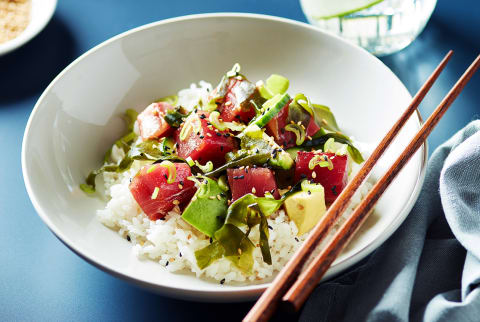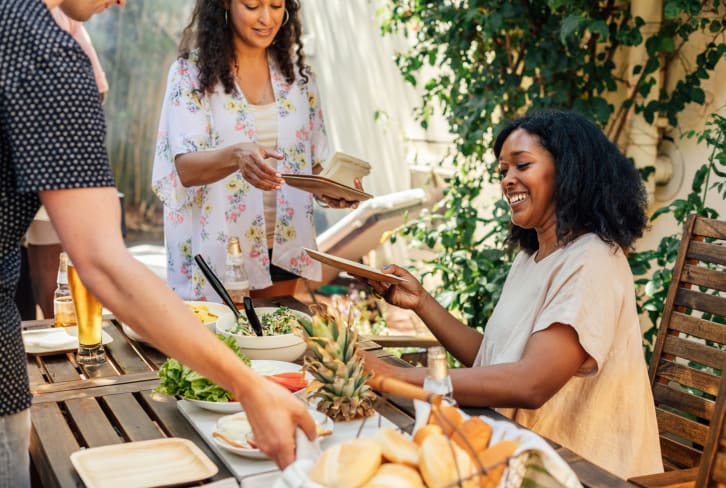Advertisement
This Super-Cheap Superfood Will Balance Your Blood Sugar ASAP


Agar agar, arame, kombu, hijiki, nori, dulse, wakame. To many Americans, the names of these glorious greens (and browns and reds) are unfamiliar. But sea vegetables (aka seaweeds) have been a staple in coastal regions around the globe—from Japan to Iceland, Ireland to the Pacific islands—for centuries, and for good reason.
Sea vegetables are really green, brown, and red marine algae, and there are thousands of types, but only a few dozen varieties are in wide consumption. Although Americans have been slow to catch on to the culinary value of sea vegetables, they are finally starting to appear in the mainstream as additions to soups, salads, and even on pizza.
I think they’re poised to be the next kale. Here’s why.
A deep dive into seaweed's nutritional superpowers.
Just as leaves of spinach or chard blow in the breeze, sea vegetables sway with the tides. And just like most terrestrial vegetables, those from the sea are also low in calories and rich in vitamins and minerals.
But sea vegetables have extra superpowers: They boast a soluble fiber content that rivals that of many beans. (Soluble fiber is the type of fiber best known for helping reduce LDL cholesterol, the bad kind, and it also plays a role in helping us to feel full.) They also have a much higher protein content than their leafy land-based cousins.
And that’s not all! Sea vegetables can act as a prebiotic, a type of indigestible fiber that feeds healthy gut flora and helps it thrive, contributing to a healthy gut balance. While they’re low in fat, the fats they do contain are heart-protective omega-3 fatty acids similar to those found in wild fish and other seafoods.
Sea vegetables are also one of the best food sources of iodine (which is essential for thyroid function) and a good source of phenolic compounds, a group of plant chemicals that may provide a host of health benefits including antioxidants, anti-inflammatory, and anti-clotting properties.
This is what studies have shown us so far:
- Sea veggies have heart. Based on their known nutritional qualities, sea vegetables are ripe for a role in the prevention of cardiovascular disease1. Much like land-based vegetables, and maybe even more powerful than them, they contain a wide range of nutrients that are associated with keeping the heart healthy, such as antioxidants, soluble fiber, and omega-3s.
- They’re stable. Sea vegetables contain compounds that may help stabilize blood sugar levels and even ward off type 2 diabetes2. The type of fiber they contain helps slow down the absorption rate of food carbohydrates, which means better blood sugar levels. A specific antioxidant call fucoxanthin may help reduce insulin resistance3.
- They’re brainy (and beneficial). Sea vegetables are being researched as true brain food4. A varied diet that includes them may help defend against cognitive disorders such as dementia, Alzheimer’s disease, and depression due to their beneficial fatty acid profile and high level of antioxidants.
- The future is bright. A 2010 study of Korean women showed a possible link between seaweed consumption and a reduction in risk for breast cancer5, but more research is needed.
The umami tsunami.
In addition to heroic nutritional powers, sea vegetables also offer tons of umami, that fifth savory taste that’s the yum factor in foods like aged Parmesan, soy sauce, aged steak, and mushrooms.
Is there any downside?
Unless you overdo it with supplements or dried seaweed (which provide concentrated sources of nutrients), there’s not much risk to eating sea vegetables. But, like anything, there are a few things to consider. Like any food from the sea, it’s possible for sea vegetables to absorb heavy metals like mercury from the environment. So, as a precautionary measure, aim to eat sea vegetables no more than three times a week, and vary your brands and types to minimize risk. Most companies test their product for heavy metals, and the U.S. Food and Drug Administration regulates the amounts found in food—but not in supplements. Also, those taking clotting medications should also proceed with caution as sea vegetables are rich in vitamin K, just like most terrestrial green vegetables.
How to get started with sea vegetables.
Remember when you thought kale was just a garnish? And then suddenly it was showing up in everything? (Hail, Kale Caesar!)
Mark my words: This is going to happen with sea vegetables, too. You can buy them fresh or dried at most Asian markets, and they are increasingly available in regular grocery stores, too. Quick ways to add them to your diet:
- use nori in place of tortillas or flatbreads for wraps
- sprinkle them over soups, salads, and stir-fries
- blend a tablespoon or two into a smoothie
- soak wakame in water for 5 minutes and toss with a drizzle of soy sauce, rice vinegar, and sesame oil for a quick seaweed salad
Here are our predictions for the rest of the big food and wellness trends of 2018.
Watch Next
Enjoy some of our favorite clips from classes
Enjoy some of our favorite clips from classes
What Is Meditation?
Mindfulness/Spirituality | Light Watkins
Box Breathing
Mindfulness/Spirituality | Gwen Dittmar
What Breathwork Can Address
Mindfulness/Spirituality | Gwen Dittmar
The 8 Limbs of Yoga - What is Asana?
Yoga | Caley Alyssa
Two Standing Postures to Open Up Tight Hips
Yoga | Caley Alyssa
How Plants Can Optimize Athletic Performance
Nutrition | Rich Roll
What to Eat Before a Workout
Nutrition | Rich Roll
How Ayurveda Helps Us Navigate Modern Life
Nutrition | Sahara Rose
Messages About Love & Relationships
Love & Relationships | Esther Perel
Love Languages
Love & Relationships | Esther Perel
What Is Meditation?
Box Breathing
What Breathwork Can Address
The 8 Limbs of Yoga - What is Asana?
Two Standing Postures to Open Up Tight Hips
How Plants Can Optimize Athletic Performance
What to Eat Before a Workout
How Ayurveda Helps Us Navigate Modern Life
Messages About Love & Relationships
Love Languages
Advertisement

These Peanut Butter Cup Protein Bites Make The Perfect On-The-Go Snack
Molly Knudsen, M.S., RDN










